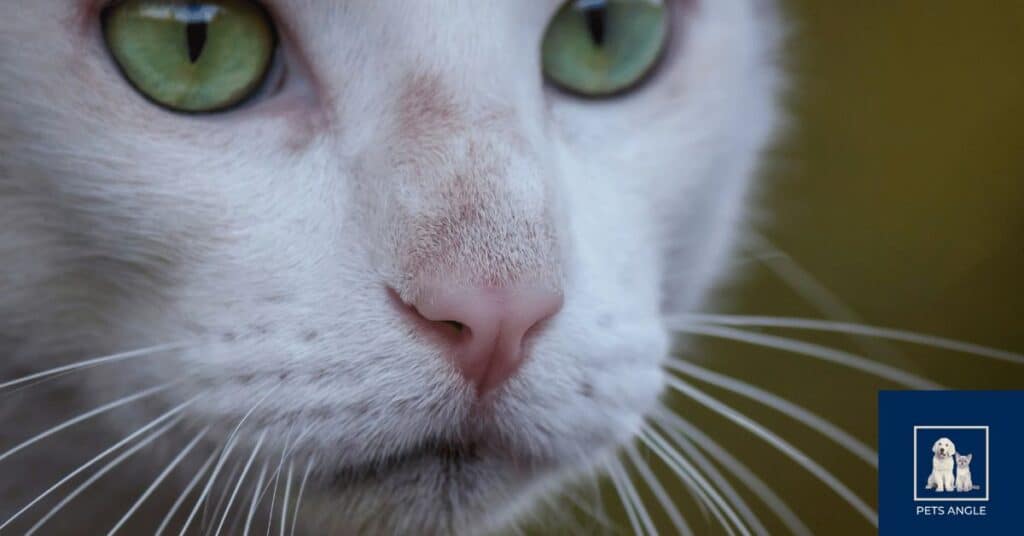Thankfully, cat whiskers are not harmful. Cats mainly use their whiskers to navigate around and express dispositions.
Having lived with cats over the years, I have observed that cat whiskers do fall off the cat’s faces once in a while, which is not unusual.
These stray whiskers can be spotted about the house and may drop off in food.
The truth is that this object from the cat’s face can be sharp in hand and might cause fear of being cut if eaten. However, no evidence has been discovered that cats’ whiskers are poisonous.
Why are the Cat’s Whiskers Supposed to Be Dangerous When Consumed?
Humans don’t usually eat cats’ whiskers unless they accidentally ingest them. Some individuals say that because the strands are strong, sharp, and pointed, they might create injuries in the stomachs and digestive tracts when swallowed.
Gastrointestinal damage from swallowed whiskers is premised on the idea that consuming sharp items might cause inside harm
Purpose of Whiskers
According to studies, cats lacking whiskers have difficulty estimating the size of holes and are more likely to become stuck.
Cats use their whiskers as keen sensory equipment to grab prey and travel through confined spaces.
Furthermore, whiskers are necessary for a cat’s equilibrium, and without them, they have difficulties walking straight and running. They also have a propensity for being lost and falling.
Cats use their whiskers to collect information about the environment around them.
What is the Composition of a Cat’s Whiskers?
Cat whiskers are extremely sensitive strands of keratin, a protein also present in hair, nails, and even feathers. They resemble antennae and have a radar-like function. They’re noticeably thicker and coarser than normal hair or fur.
Face whiskers are the most visible of any animal whiskers, and they’re an important element of a cat’s distinctive appearance.
Whiskers are well-positioned naturally above eyebrows, on the chin, forelimbs, around the ears, and above the top lip. The specific design and placement of whiskers vary by breed, but most kittens have a dozen whiskers on each cheek, grouped in four rows.
Cats shed their whiskers regularly, and the shed whiskers will regenerate during the next sloughing/regrowth phase.
Spotting shed whiskers is usual; nevertheless, if you notice significant whisker shedding in your feline companion, reach out to your vet doctor immediately to enable your cat to regain those attractive look whiskers provide.
Is Ingesting a Cat’s Whiskers and Hairs Harmful?
When a lot of cat hair is digested and clogs the digestive system, it becomes a problem. The amount of enzymes in our digestive tract is restricted. Protein will remain undigested if there are more enzymes than enzymes.
As a result, we should avoid eating cats’ whiskers and furs.
Another concern that can arise is the intentional packing of the nasal cavity with the cat’s whiskers and furs, which poses a suffocation danger.
Is there any Consequence for Touching Cat Whiskers Too Frequently?
Too many touches on a cat’s whiskers, even simple brushing against food and water dishes, trigger a barrage of sensory data to be sent to their brain.
This excessive stimulation may cause your cat to become nervous or disturbed.
Should the Whiskers of a Cat be Shaved?
Cut whiskers cause a cat to become bewildered and terrified. Shaving off the whiskers affects cats because it leads to distortion in the cat’s sense of identification.
Trimming whiskers can reduce a cat’s ability to visualize its domains, and difficulty in spatial visualization can create serious confusion for the cat. Never attempt removing or cutting off your cat’s whiskers, and also ensure you tenderly touch them when massaging the cat around its face.
Excessive Cat Whisker Shedding: What Causes It?
Whiskers are so important that cats find it difficult to thrive without whiskers.
If you detect many whiskers being shed simultaneously, as well as other symptoms like sores, scabs, hair loss, or flaky skin, you should take your cat to the veterinarian for a checkup.
Excessive whisker loss can be caused by a variety of factors, including but not limited to:
- Stress: When a cat is anxious, it tends to shed excessively, and you’ll notice a difference in the lustre and texture of its coat. Environmental changes, the introduction of a new pet or newborn, and a change in your routine can all cause stress in cats.
- Allergies: pests, dirt, pollution, and diet can cause allergies in cats. The most typical symptom of hypersensitivity in cats is localized or generalized itching of the skin, regardless of the allergen. A flare-up near the whiskers may cause them to fall out.
- Infections: Whisker loss can also be caused by skin diseases caused by bacteria or fungi. Ringworm, a fungal infection rather than a worm, is one possible cause. Hair loss in circular spots, crusty skin and damaged hair are all signs of ringworm in cats.
- Acne: Acne is not a particular human problem, but it may also affect our feline companions. Acne in felines is due to excess grease in a cat’s hair cavity.
Acne in the cat is usually around the jaws and lips. Scratches, rashes and sores grow around those dental areas due to acne, prompting a cat to wipe its head against surfaces in the house.
- Cat battles: If your cat gets into a brawl with a fellow indoor or outdoor cat, your cat may lose numerous whiskers to the fight if the cat is attacked in the face.
An approach to curtail fights among cats is to provide various bowls, beds, litter boxes, toys, and other supplies. Restricting the cat indoors can also prevent it from wandering around

